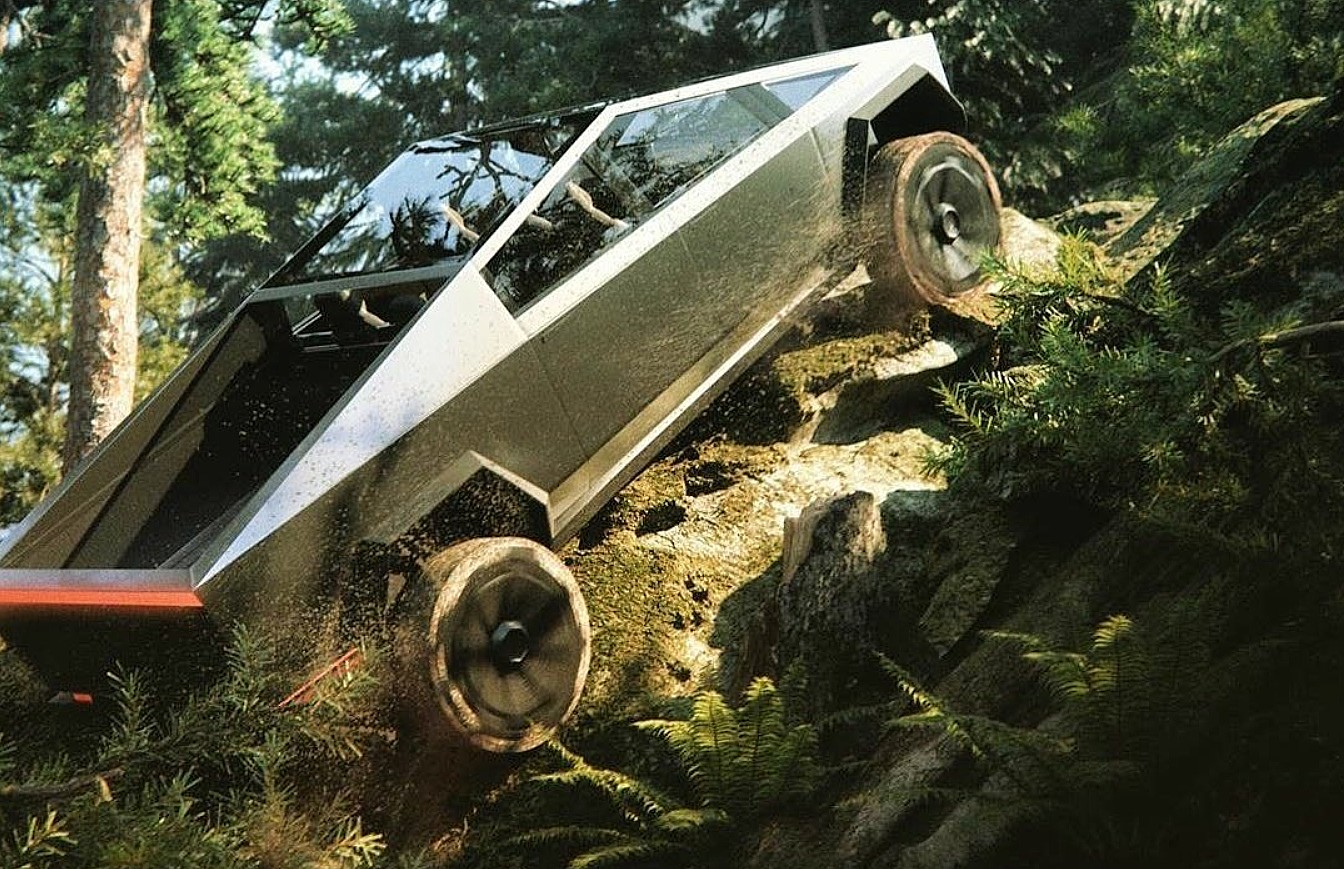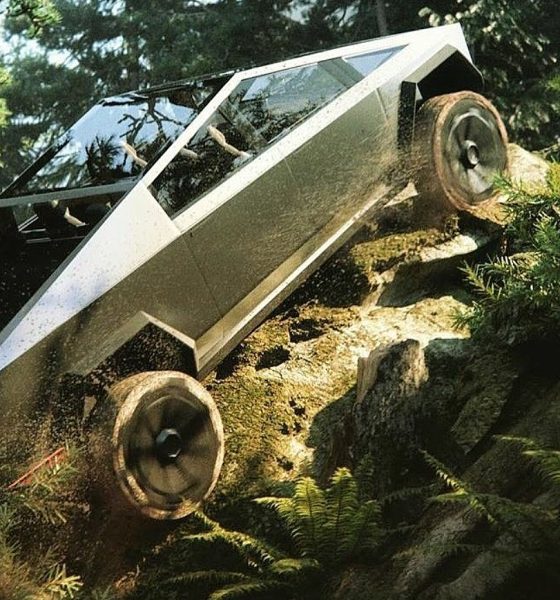

News
Tesla Cybertruck isn’t better than 1949 technology when it comes to off-roading, says popular Trucking channel
The Tesla Cybertruck is, without a doubt, one of the most discussed vehicles in recent memory. The pickup’s polarizing and robust design has vehicle fanatics raving about the possibility of changing the tune of the American truck market today. In a recently published video from The Fast Lane Car YouTube channel, the team discussed why they believe the Cybertruck will fail to be an effective mode of off-road transportation. They highlight its heavy-weight and low-body design as two of the reasons it will fall short of impressively navigating through rocks and trails.
“If you look at what you need for off-road ability, you need ground clearance, you need gearing, you need articulation, you need underbody protection, right?” The trucking experts add, “If you look at the off-road tech, the stuff that you needed back in 1949 is the stuff you still need in 2020-2021.”
Typically, offroading vehicles that find success in challenging terrain have short wheelbase are lightweight and tend to told hold higher-than-normal ground clearances that assist in traveling over sharp crests on trails. TFL’s Tommy Mica highlights these attributes during the video, stating that an offroading vehicle’s biggest enemy is weight.
“Just like on-road, the enemy to off-road is weight. The lighter the weight, the easier it is to crawl up obstacles to maneuver difficult situations. The Cybertruck is going to be huge and is going to be monstrously heavy,” Mica says.
While it is ideal to have a lighter vehicle for offroading situations, that does not mean a heavy car will have issues 100% of the time. In fact, there are many vehicles that hold a weight that is similar to the Cybertruck’s estimated 5,000-6,500 pound curb rating. One is the 2019 Ford F-150 Raptor, a truck that was recognized by Popular Mechanics as one of the top 12 best off-road vehicles available. Weighing in at over 5,500 pounds, the Raptor has been spotted climbing intimidating stretches of steep offroading trails without much of an issue.
Additionally, Mica states that the Cybertruck’s low ground clearance will inhibit the vehicle’s ability to navigate over steep land grades and sharp objects on a trail. However, the Cybertruck’s 16″ ground clearance is higher than the 8.7″ measurement of the top-ranked 2019 Ram 1500 Rebel from Dodge and the previously mentioned F-150 Raptor’s 11.5″ clearance.
TFL tested a Long-Range configuration of the Model X in its off-road tests. Citing a diminished loss of range due to increased power usage, and increased worry over puncturing the vehicles underbody battery pack made their experience not-so-memorable. However, the Model X was never aimed toward off-road performance specifically. While the electric SUV does have traction control capabilities that have performed well on off-road courses in the past, the Model X was not meant for navigating through vicious trails of rocks, branches, and uneven terrain.
Even so, using the Model X’s performance as an off-road vehicle as the basis to prove the Cybertruck’s inability to function on trails just seems silly. The two cars maintain entirely different packages. Comparing a Ford Escape’s off-road performance to the F-150 Raptor’s wouldn’t be justifiable either, as the two vehicles are completely different and aimed toward different functions.
Besides, Tesla CEO Elon Musk has stated that the Cybertruck’s size and dimensions are not finalized. In early December 2019, Musk said the width and length would both be revised to fit inside a residential garage. “We can prob reduce width by an inch & maybe reduce length by 6+ inches without losing on utility or aesthetics,” Musk said.
The Cybertruck’s off-road performance won’t be solidified until the release of its Dual and Tri motor variants in 2021. However, there is plenty of evidence to suggest that the electric truck will be more than capable of holding its own in tight terrain, especially considering its most powerful variant packs a tremendous punch.
Watch The Fast Lane Car’s video mentioning the Cybertruck’s offroading ability below.

News
Tesla FSD fleet is nearing 7 billion total miles, including 2.5 billion city miles
As can be seen on Tesla’s official FSD webpage, vehicles equipped with the system have now navigated over 6.99 billion miles.

Tesla’s Full Self-Driving (Supervised) fleet is closing in on almost 7 billion total miles driven, as per data posted by the company on its official FSD webpage.
These figures hint at the massive scale of data fueling Tesla’s rapid FSD improvements, which have been quite notable as of late.
FSD mileage milestones
As can be seen on Tesla’s official FSD webpage, vehicles equipped with the system have now navigated over 6.99 billion miles. Tesla owner and avid FSD tester Whole Mars Catalog also shared a screenshot indicating that from the nearly 7 billion miles traveled by the FSD fleet, more than 2.5 billion miles were driven inside cities.
City miles are particularly valuable for complex urban scenarios like unprotected turns, pedestrian interactions, and traffic lights. This is also the difference-maker for FSD, as only complex solutions, such as Waymo’s self-driving taxis, operate similarly on inner-city streets. And even then, incidents such as the San Francisco blackouts have proven challenging for sensor-rich vehicles like Waymos.
Tesla’s data edge
Tesla has a number of advantages in the autonomous vehicle sector, one of which is the size of its fleet and the number of vehicles training FSD on real-world roads. Tesla’s nearly 7 billion FSD miles then allow the company to roll out updates that make its vehicles behave like they are being driven by experienced drivers, even if they are operating on their own.
So notable are Tesla’s improvements to FSD that NVIDIA Director of Robotics Jim Fan, after experiencing FSD v14, noted that the system is the first AI that passes what he described as a “Physical Turing Test.”
“Despite knowing exactly how robot learning works, I still find it magical watching the steering wheel turn by itself. First it feels surreal, next it becomes routine. Then, like the smartphone, taking it away actively hurts. This is how humanity gets rewired and glued to god-like technologies,” Fan wrote in a post on X.
News
Tesla starts showing how FSD will change lives in Europe
Local officials tested the system on narrow country roads and were impressed by FSD’s smooth, human-like driving, with some calling the service a game-changer for everyday life in areas that are far from urban centers.

Tesla has launched Europe’s first public shuttle service using Full Self-Driving (Supervised) in the rural Eifelkreis Bitburg-Prüm region of Germany, demonstrating how the technology can restore independence and mobility for people who struggle with limited transport options.
Local officials tested the system on narrow country roads and were impressed by FSD’s smooth, human-like driving, with some calling the service a game-changer for everyday life in areas that are far from urban centers.
Officials see real impact on rural residents
Arzfeld Mayor Johannes Kuhl and District Administrator Andreas Kruppert personally tested the Tesla shuttle service. This allowed them to see just how well FSD navigated winding lanes and rural roads confidently. Kruppert said, “Autonomous driving sounds like science fiction to many, but we simply see here that it works totally well in rural regions too.” Kuhl, for his part, also noted that FSD “feels like a very experienced driver.”
The pilot complements the area’s “Citizen Bus” program, which provides on-demand rides for elderly residents who can no longer drive themselves. Tesla Europe shared a video of a demonstration of the service, highlighting how FSD gives people their freedom back, even in places where public transport is not as prevalent.
What the Ministry for Economic Affairs and Transport says
Rhineland-Palatinate’s Minister Daniela Schmitt supported the project, praising the collaboration that made this “first of its kind in Europe” possible. As per the ministry, the rural rollout for the service shows FSD’s potential beyond major cities, and it delivers tangible benefits like grocery runs, doctor visits, and social connections for isolated residents.
“Reliable and flexible mobility is especially vital in rural areas. With the launch of a shuttle service using self-driving vehicles (FSD supervised) by Tesla in the Eifelkreis Bitburg-Prüm, an innovative pilot project is now getting underway that complements local community bus services. It is the first project of its kind in Europe.
“The result is a real gain for rural mobility: greater accessibility, more flexibility and tangible benefits for everyday life. A strong signal for innovation, cooperation and future-oriented mobility beyond urban centers,” the ministry wrote in a LinkedIn post.
News
Tesla China quietly posts Robotaxi-related job listing
Tesla China is currently seeking a Low Voltage Electrical Engineer to work on circuit board design for the company’s autonomous vehicles.

Tesla has posted a new job listing in Shanghai explicitly tied to its Robotaxi program, fueling speculation that the company is preparing to launch its dedicated autonomous ride-hailing service in China.
As noted in the listing, Tesla China is currently seeking a Low Voltage Electrical Engineer to work on circuit board design for the company’s autonomous vehicles.
Robotaxi-specific role
The listing, which was shared on social media platform X by industry watcher @tslaming, suggested that Tesla China is looking to fill the role urgently. The job listing itself specifically mentions that the person hired for the role will be working on the Low Voltage Hardware team, which would design the circuit boards that would serve as the nervous system of the Robotaxi.
Key tasks for the role, as indicated in the job listing, include collaboration with PCB layout, firmware, mechanical, program management, and validation teams, among other responsibilities. The role is based in Shanghai.
China Robotaxi launch
China represents a massive potential market for robotaxis, with its dense urban centers and supportive policies in select cities. Tesla has limited permission to roll out FSD in the country, though despite this, its vehicles have been hailed as among the best in the market when it comes to autonomous features. So far, at least, it appears that China supports Tesla’s FSD and Robotaxi rollout.
This was hinted at in November, when Tesla brought the Cybercab to the 8th China International Import Expo (CIIE) in Shanghai, marking the first time that the autonomous two-seater was brought to the Asia-Pacific region. The vehicle, despite not having a release date in China, received a significant amount of interest among the event’s attendees.








